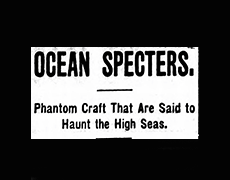
There are numerous old reports of Flying Dutchman sightings, with the most eery of them being logged in 1881 by the captain of the H.M.S. Bacchante.
The following article, originally published in 1913, covers possible origin stories of the Flying Dutchman and cites a few other ghost ships that have been seen in the past.
Ocean Specters
There are numerous legends and stories of ghostly vessels that roam the briny deep, and many hard headed mariners, free from the common superstition of the ordinary sailor man, who stoutly maintain that they have at least once in their maritime career encountered what was undoubtedly a phantom ship.
Best known of those mysterious craft that haunt the high seas is, of course, the famous Flying Dutchman, or phantom ship of Vanderdecken.

How the story originated is doubtful, but it has been ascertained that there was a seaman of repute who many years ago sailed from Holland to the east via the Cape of Good Hope, but was never again heard of.
Some authorities say that, meeting with contrary winds off the cape, he swore a terrible oath, in consequence of which the divine wrath decreed that he should be occupied till the crack of doom in endeavoring to weather the headland.
Others state that this punishment was meted out to him in retribution for a terrible murder he committed before commencing his fateful voyage.
Whatever the cause of this ancient gentleman’s monotonous wandering may be, it is probably in connection with him that the most authentic and cold blooded record of any phantom exists either afloat or ashore, for it is stated that in the log of H.M.S. Bacchante while on a voyage round the world with the little princes in 1881 there appears on July 11 the entry:
Flying Dutchman crossed our bows.
The log book of one of the then largest of her majesty’s warships is certainly the very last place to expect to find that which is generally associated with the hysterical of either sex.
During January, 1647, a vessel left New Haven, Conn., on her maiden voyage, but was never again heard of.
In the following June, just before the hour of sunset and after a severe thunderstorm, the missing ship was seen sailing up the river.
The inhabitants, taking their evening stroll, were overjoyed at her return, but the most observant of them noticed that there was something uncanny about her, especially in that she appeared to be sailing up against the wind.
Then, to the consternation of all, she gradually faded away before their eyes and entirely disappeared.
We may be assured that there were not wanting those who maintained that the vessel in spirit had paid a last visit to her port before resting for good on the ocean bed.
In the “Chronicles of the St. Lawrence” by Le Maine, it is recorded that on a certain day in the year a phantom ship is seen off Cap d’Espoir in Gaspe bay. Lights are seen aboard her, and her decks are crowded with men.
By the foot of the bowsprit a man is conspicuously standing and facing toward the shore, with a lady clinging to his arm.
Gradually the lights go out and the vessel sinks.
It is said to be the ghost of the flagship of a fleet which was sent out to reduce the French forts, the vessel being lost with all hands.
To come to British water, there are numerous instances related in local history of the visitations of ghostly vessels, the west of England, as might be expected, being most prolific in these records, says a writer in the London Globe.
Indeed, Cornwall boasts of a goblin ship probably unique the world over, as she not only sails the water, but proceeds most unconcerned a good distance inland.
This is the specter ship of Porthcurno, and in Robert Hunt’s book on “Romances of the West of England” are related the experiences of a local inhabitant who witnessed one of her escapades. She is described as a black square rigged single masted vessel, sometimes towing a small boat.
No crew are ever seen; presumably they are down below.
The personal narrative goes on to say:
On came the craft. It passed steadily through the breakers, glided up over the sands, steadily pursued its course on the dry land as if it had been water. On it went to Bodelan, where St. Leven formerly dwelt. It then steered its course to Chygwiden and there vanished like smoke.
Source: Bismarck daily tribune. (Bismarck, Dakota [N.D.]), 05 April 1913.

